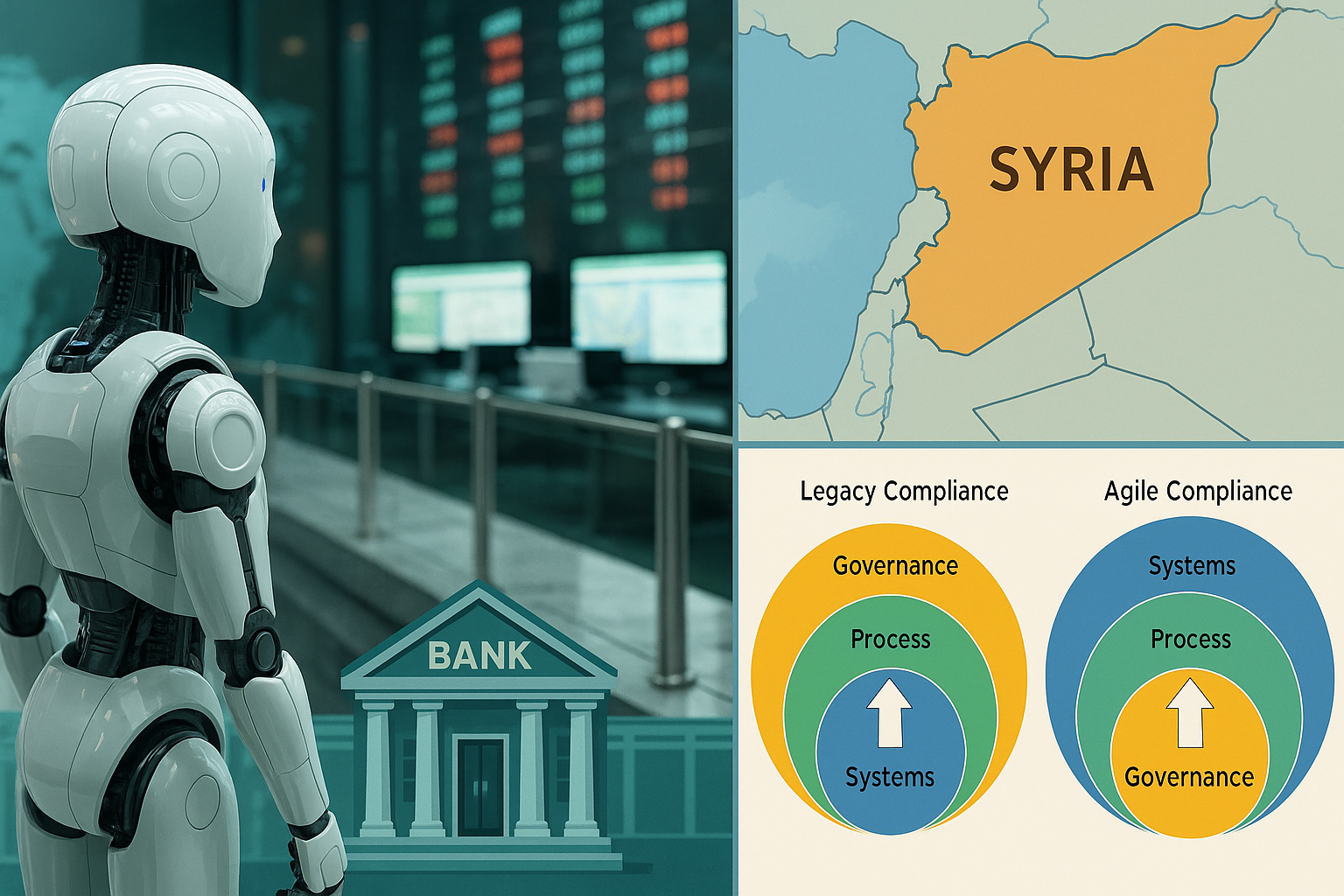Syrian Sanctions: Guardrail AI Can Help Bank BSA/AML with Agile Compliance
 On May 13, 2025, the U.S. government announced a significant easing of long-standing economic sanctions on Syria, authorizing expanded engagement in select commercial sectors. While this policy shift marks a turning point in U.S. foreign policy, for financial institutions, it represents something more fundamental: a comprehensive reconfiguration of BSA/AML (Bank Secrecy Act / Anti-Money Laundering) strategy.
On May 13, 2025, the U.S. government announced a significant easing of long-standing economic sanctions on Syria, authorizing expanded engagement in select commercial sectors. While this policy shift marks a turning point in U.S. foreign policy, for financial institutions, it represents something more fundamental: a comprehensive reconfiguration of BSA/AML (Bank Secrecy Act / Anti-Money Laundering) strategy.
This transition from comprehensive restriction to selective reintegration will challenge banks to evolve their compliance frameworks rapidly, precisely, and securely. The real test won't simply be regulatory interpretation, but operational readiness: distinguishing newly permissible activity from persistent high-risk exposure in a jurisdiction that remains flagged for money laundering and terrorist financing.
Enter Guardrail AI—an intelligent compliance architecture built to align regulatory policy with operational agility. In an era when regulatory change can arrive overnight, Guardrail AI can provide banks with the tools to modernize governance, automate screening systems, and reduce risk as sanctioned economies transition into conditional legitimacy.
The Syrian Sanctions Shift: From Blanket Prohibition to Targeted Access
For over a decade, Syria has been designated a high-risk jurisdiction, with sweeping U.S. sanctions isolating most Syrian entities and individuals from the global financial system. In response, banks developed stringent compliance firewalls: automated blocks, escalation protocols, and rigid interpretation of OFAC guidance.
With recent policy changes now in effect, U.S. persons may engage in specific economic activities in Syria—but the compliance paradox deepens. Many Syrian actors remain under SDN restrictions. Syria also continues to be identified by FinCEN as a jurisdiction of primary money laundering concern, and the country remains on the FATF gray list.
As banks navigate this partial opening, they must manage dual realities: reengagement with authorized Syrian sectors and businesses, while maintaining continued vigilance against prohibited or high-risk actors, fronts, and sanctions evasion.
This creates a complex risk environment requiring a shift from binary compliance models to real-time, rules-driven decision intelligence. Key near-term challenges include:
Screening Recalibration: OFAC lists have already been updated to reflect new licensing terms. Screening engines must ingest revised entity data and apply nuanced logic across jurisdictions, sectors, and aliases.
Surge Preparation: Banks may experience new onboarding requests and inbound payment flows involving previously restricted Syrian counterparties, including remittances and regional trade finance.
Residual Risk Management: Sophisticated bad actors may attempt to exploit the transition by using legitimate-looking businesses or layered intermediaries to gain access.
Policy Ambiguity: Sanctions relief is partial and reversible. Banks must interpret frequently updated guidance and manage inconsistent global adoption of the new U.S. stance.
Guardrail AI: Three Pillars of Intelligent Compliance
Guardrail AI, as outlined in our framework for modernized banking, can address these challenges through three core capabilities:
1. Regulation-to-Policy Translation
Large Language Models (LLMs) can instantly parse OFAC updates, guidance notes, and FinCEN advisories. Within hours of regulatory publication:
- Redlined comparisons to internal compliance policies can be generated
- Impact zones (KYC, onboarding, correspondent clearing) can be flagged
- Draft internal compliance policies can be prepared for review and approval
This capability can shorten the reaction window from weeks to hours, ensuring operational alignment while maintaining human oversight.
2. Dynamic Risk Scoring and Screening
Machine learning models can dynamically score customers and counterparties based on behavior, sector, region, and updated sanctions intelligence. For instance:
- A Syrian telecom provider submitting updated business documentation can be benchmarked against peer profiles and historical anomaly patterns
- Screening engines can ingest real-time SDN/NS-PLC updates, apply fuzzy logic to identify known aliases and transliterated names, and cross-reference activity against global red flag indicators
Instead of static allow/deny lists, institutions can operate adaptive risk frameworks that reflect fast-moving geopolitical and regulatory realities.
3. Deterministic Controls and Agentic Intelligence
Guardrail AI can embed deterministic business rules—no new accounts, remittance corridors, or correspondent relationships will be permitted without passing rule-based validation (e.g., sector license coverage, exposure thresholds, documentation checklists).
AI agents can handle low-risk workflows such as remittance screening and transaction velocity monitoring, escalating edge cases to compliance officers trained to audit AI decisions and override with justification.
This hybrid approach can fuse machine efficiency with human judgment and create resilient workflows that scale.
Aligning Policy, Process, and Technology
A modern compliance architecture requires more than automation—it requires governance that aligns three vectors:
Policy: Generated from regulation by LLMs with full traceability
Process: Embedded in rule-based workflows that apply policy in real time
Technology: Ensuring scalability, explainability, and continuous feedback
Amberoon's Agile Compliance framework can help bridge these layers, ensuring that automation remains controlled and every decision maintains an audit trail.
The Future of Intelligent Compliance
The easing of U.S. sanctions on Syria is not blanket forgiveness—it is a calibrated opening that preserves the expectation of continued diligence and risk control. For banks, this transition phase exemplifies "regulatory whiplash": yesterday's prohibited activity now demands differentiation, nuance, and agile governance.
Guardrail AI can offer a scalable pathway for institutions to modernize their compliance stack—not just to keep pace with policy change, but to lead with intelligence, automation, and accountability.
In the new world of adaptive compliance, success will not go to the fastest—it will go to the most prepared.
Ready to transform your institution's compliance capabilities? Explore Guardrail AI today and build resilience against the next policy shift. Send email to guardrailai@amberoon.com. For more on the foundational concepts, read our original Guardrail AI blog.
Posts by Tag
- big data (41)
- advanced analytics (38)
- business perspective solutions (30)
- predictive analytics (25)
- business insights (24)
- data analytics infrastructure (17)
- analytics (16)
- banking (15)
- fintech (15)
- regulatory compliance (15)
- risk management (15)
- regtech (13)
- machine learning (12)
- quantitative analytics (12)
- BI (11)
- big data visualization presentation (11)
- community banking (11)
- AML (10)
- social media (10)
- AML/BSA (9)
- Big Data Prescriptions (9)
- analytics as a service (9)
- banking regulation (9)
- data scientist (9)
- social media marketing (9)
- Comminity Banks (8)
- financial risk (8)
- innovation (8)
- marketing (8)
- regulation (8)
- Digital ID-Proofing (7)
- data analytics (7)
- money laundering (7)
- AI (6)
- AI led digital banking (6)
- AML/BSA/CTF (6)
- Big Data practicioner (6)
- CIO (6)
- Performance Management (6)
- agile compliance (6)
- banking performance (6)
- digital banking (6)
- visualization (6)
- AML/BSA/CFT (5)
- KYC (5)
- data-as-a-service (5)
- email marketing (5)
- industrial big data (5)
- risk manangement (5)
- self-sovereign identity (5)
- verifiable credential (5)
- Hadoop (4)
- KPI (4)
- MoSoLoCo (4)
- NoSQL (4)
- buying cycle (4)
- identity (4)
- instrumentation (4)
- manatoko (4)
- mathematical models (4)
- sales (4)
- 2015 (3)
- bitcoin (3)
- blockchain (3)
- core banking (3)
- customer analyitcs (3)
- direct marketing (3)
- model validation (3)
- risk managemen (3)
- wearable computing (3)
- zero-knowledge proof (3)
- zkp (3)
- Agile (2)
- Cloud Banking (2)
- FFIEC (2)
- Internet of Things (2)
- IoT (2)
- PPP (2)
- PreReview (2)
- SaaS (2)
- Sales 2.0 (2)
- The Cloud is the Bank (2)
- Wal-Mart (2)
- data sprawl (2)
- digital marketing (2)
- disruptive technologies (2)
- email conversions (2)
- mobile marketing (2)
- new data types (2)
- privacy (2)
- risk (2)
- virtual currency (2)
- 2014 (1)
- 2025 (1)
- 3D printing (1)
- AMLA2020 (1)
- BOI (1)
- DAAS (1)
- Do you Hadoop (1)
- FinCEN_BOI (1)
- Goldman Sachs (1)
- HealthKit (1)
- Joseph Schumpeter (1)
- Manatoko_boir (1)
- NationalPriorites (1)
- PaaS (1)
- Sand Hill IoT 50 (1)
- Spark (1)
- agentic ai (1)
- apple healthcare (1)
- beneficial_owener (1)
- bsa (1)
- cancer immunotherapy (1)
- ccpa (1)
- currency (1)
- erc (1)
- fincen (1)
- fraud (1)
- health app (1)
- healthcare analytics (1)
- modelling (1)
- occam's razor (1)
- outlook (1)
- paycheck protection (1)
- personal computer (1)
- sandbox (1)
Recent Posts
Popular Posts
Here is a funny AI story.
Every community bank CEO now faces unprecedented...
On May 13, 2025, the U.S. government announced...



